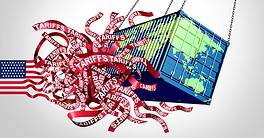Poring over spreadsheets won’t solve all cash flow challenges.

Augmenting spreadsheets with artificial intelligence (AI) saves valuable time, which can be better spent in forecasting cash trends and helping to overcome key challenges such as automated data gathering and integration from multiple sources. Treasurers can apply algorithms to build highly accurate forecasts and track variance, especially if they use machine learning (ML) to tweak models. All that means a powerful boost for those who can successfully deploy AI in corporate finance.
According to industry-analysis firm Gartner’s report on the future of financial planning and analysis, titled Predicts 2023: The Impact of Autonomous Technologies on FP&A and Controller Processes, “50% of organizations will have replaced time-consuming, bottom-up forecasting approaches with AI.” The prediction is that this will result in operational, demand, and other types of planning becoming autonomous by 2028. While 64% of CFOs believe autonomous finance—incorporating self-learning and self-correcting technology—can become a reality within six years, only 21% are now using ML, 19% prescriptive analytics, and 12% natural language processing.
For those willing to take the plunge, the rewards are worth reaping. US envelope manufacturer Cenveo achieved 93% forecast accuracy and 90% productivity improvements after implementing Kyriba’s Enterprise Liquidity Management platform, which employs AI-powered, data-driven decision-making, along with predictive analytics, while unifying real-time data and workflows.
Within eight weeks, the company eliminated more than 600 cross-functional hours per month. Cenveo made an additional $1 million as the treasury was able to dedicate resources to other projects rather than spending time just managing cash —propelling it to the level of a strategic partner in the eyes of Cenveo’s C-suite.
Bob Stark, global head of market strategy at enterprise liquidity, payments, and risk management firm Kyriba, says the primary use cases for AI in treasury organizations are to improve existing data (cash forecasting), detect fraudulent transactions, and generate new insights (liquidity planning).
“AI has supported payment-fraud detection for several years, using an adversarial approach to confirm good payments and flag suspicious payments that warrant further review,” he says. “Cash forecasting is a more recent use case, where we see treasury teams wanting AI to predict a more accurate clear date or payment amount than what their [enterprise resource planning for accounts payable or accounts receivable] data provided them. Generating new data insights is an emerging area, inspired by large language models and ChatGPT, and fueled by the need to plan liquidity needs to support M&A and entry into new markets where historical data simply did not exist.”
Rising interest rates and currency fluctuations require treasurers to subject portfolios to stress tests under different scenarios. “AI has been beneficial for short-term cash forecasting, where users can utilize it not only to improve accurate prediction of cash flows for the coming days by training the AI algorithm with historical data, but also to set a confidence interval for how precise they need forecasts to solve for,” Stark adds. “The challenge with more legacy cash forecasting has always been the level of certainty in forecasts. By empowering treasury teams with confidence in their data, the AI model can predict the cash cushion needed for each forecast scenario.”
Software firm Icertis employs AI for contract life cycle management, enabling companies to achieve strategic advantage. “Everything a company does is captured in a contract—whether buying, selling, or hiring. Digitization transforms static documents into living agreements that can then interact with humans, surrounding systems, and other contracts. We take all the structured and unstructured data. Then we apply AI to surface information that supports better business decisions, providing insights into the contract and how it can be improved,” explains Rajat Bahri, CFO of Icertis.
This provides more revenue for customers, because they can implement pricing better. “They can optimize payment terms, improve negotiations and avoid compliance penalties,” adds Bahri.
Generative AI Business Boost
The launch of Icertis Contract Intelligence Copilots in July—a set of generative AI (genAI) applications for enterprise contract management—built on Icertis ExploreAI Service and backed by Microsoft Azure, will enable executives, legal teams and business users alike to harness generative AI and turn their commercial agreements into interactive assets.
Bahri insists it will be a game-changer that will accelerate many things. “If you’re a procurement guy, you could ask, ‘How can I expedite contract approvals?’ or, ‘Which standard clauses are missing?’ and it will respond to you. If you’re a financial or legal person, you can ask a different set of role-based questions.”
According to Bill Borden, corporate vice president of Worldwide Financial Services for Microsoft, offerings such as Azure OpenAI Service; Microsoft 365 Copilot; ChatGPT; and ChatGPT Plus, with GPT-4, are helping Microsoft’s customers to improve operations and drive efficiencies while ensuring that data stays within the bounds of their organizations, allowing for the transformation of tasks such as writing assistance and content generation, reasoning using structured and unstructured data, and summarization of reports and texts.
“Some use cases we’re seeing for generative AI in treasury management include summarizing microdata and financial news for the investment team; quickly extracting insights on payments, cash positioning and bank accounts; and the ability to scan for financial sector risk signals and recommend remediation, among others,” states Borden.
He says banks are exploring how genAI can accelerate content development, such as pitch books. Investment banks use pitch books to generate a proposal for a capital raise or M&A for an institutional investor. They are developed collaboratively with content from multiple sources, such as an overview of the client, the deal strategy, and marketing materials. “For every content generation scenario,” counsels Borden, “human oversight is critical to ensure the quality and accuracy of generated content.”
Icertis is also working with banks that see opportunities for M&A contracts. “Think about the compliance that they are going to have to go through—they have to read something like 300 pages of documents and figure them out,” states Bahri, who sees both customer-facing and back-office benefits to AI.
Kyriba’s Stark predicts an exciting future for AI in treasury: “What we have seen in the past eight months with ChatGPT is the possibility of AI being used for automation, replacing the mouse to interact with your treasury management system.”
Although more innovation is needed to ensure that treasury data remains secure, large language models have seemingly democratized AI for those in treasury who couldn’t visualize what AI could do for them. Using even the most basic language prompts within a treasury-software platform, treasury teams can ask, “What is my available cash balance?” or “How accurate was my cash forecast last week?”
In May, cash management fintech Trovata rolled out a beta version of Trovata AI using OpenAI’s ChatGPT technology, enabling customers to ask open-ended and complex questions such as, “Give me a report showing all of my company’s cash outflows by cash flow type,” or “Provide me with a list of cash inflows in US dollars greater than $10,000 for the past month.”
Letting machines do the heavy data crunching should help rather than replace workers. “It makes people smarter and creates efficiency,” Bahri insists. “So they can focus on strategic initiatives that really require their brain power.”
Stark notes that the next level of genAI in treasury will allow language prompts to access screens and reports, deliver predictive insights to drive better-informed decision-making, and construct new processes with extreme automation and efficiency. He says, “It is reasonable to expect that we will be able to ask our AI-driven treasury system, ‘Why was my forecast inaccurate, and what can I do to fix it?’ and similarly ask it to ‘build a hedging program that maximizes my coverage and minimizes my cost.’ These AI innovations, seemingly more fantasy than reality at this time last year, are now the next steps that treasurers will feel are just around the corner.”



